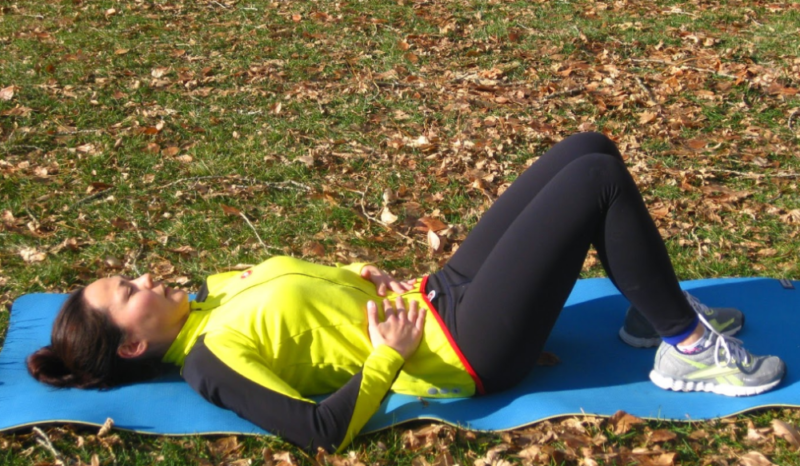People strive to get a perfect figure with a chiseled waist and elastic press, without exhausting themselves with long trainings in the gym. However, the efforts made do not always eliminate the hated fat on the sides and bottom of the navel, which is creased. But there is a simple exercise that allows you to narrow the waist line, tighten the muscles and skin of the abdominal region. This is a vacuum of the abdomen - an integral practice of yogis and athletes, which has gained popularity among ordinary people.
Material Content:
What is a stomach vacuum
Vacuum is perhaps the most effective practice that can improve the mobility of the transverse abdominal muscles and relieve a couple of centimeters at the waist. Since the movements are primarily respiratory, conscientious and clear execution of the exercise involves the diaphragm and muscles of the body. This allows you to increase the saturation of tissues and organs with oxygen, as well as work out muscle fibers, which are rarely used under normal loads.
The abdominal muscles (from the Latin abdomen - belly) consist of a group of external muscles that are outlined after training (straight and oblique) and internal (transverse and internal oblique) - invisible to the eye, but serving as a specific framework for the abdominal organs. A sedentary lifestyle, the consumption of excess calories and the lack of an adequate load - leads to weakness of the invisible frame.That is why a layer of fat (unclaimed for nutrition of the body) is formed around the abdomen, and the gastrointestinal tract begin to literally fall out, which makes the stomach visually even larger.
The vacuum is aimed at the study of the fibers of the transverse abdominal muscle due to stretching, maintaining the organs in their natural position and accelerating the mechanism of lipid breakdown.
The benefits of losing weight
If you describe the benefits of regular practice, the list will be as follows:
- active fat burning;
- narrowing of the waist;
- prevention of prolapse of internal organs;
- reduction in the amount of food consumed due to a slight decrease in the stomach;
- normalization of the digestive tract and stimulation of digestion;
- improvement of blood microcirculation;
- elimination of congestion in the pelvis;
- normalization of the cycle with functional dysmenorrhea and / or PMS (in women);
- development and strengthening of intercostal muscles;
- the formation of proper posture, the study of back muscles;
- healing and rejuvenation of the body due to the saturation of tissues with oxygen due to special breathing techniques.
Of course, losing weight using only one exercise is almost impossible, because to create a beautiful and toned figure you need a proper and balanced diet. However, the implementation of the vacuum will help to shape the waist, by including muscles that are rarely used in the normal state.
Types of exercise: the magnificent four
There are 4 modifications to doing a vacuum exercise. They differ in the position of the housing and the degree of complexity.
At the same time, the technique itself remains unchanged and is described in detail in the next block. But first you need to consider the correct position of the body.
The version for beginners is on the back, because the force of gravity pulls the internal organs to the ridge. A little more difficult are given options while standing and sitting. Standing on all fours is available only to advanced ones, because in this position it is important to keep the spine level and overcome the influence of gravity.
The lying vacuum goes like this:
- Starting position on the back, legs bent, heels on the floor, hands lying arbitrarily.
- After a measured exhalation, you need to retract the stomach.
- Hold this position with bated breath.
- With a false exhalation, relax the abs.
- Take 3 to 4 calm breaths and repeat the main exercise.
The sequence of actions in a vacuum standing:
- Place your palms on your belt or on a high support, keep your back straight, slightly lower your chin to your chest.
- Release all air from the lungs and tighten the stomach.
- Hold at least 10 - 15 accounts, and then relax.
Vacuum sitting additionally involves the muscles of the back:
- Sit on a hard surface so that your hips are parallel to the floor.
- Keep your back straight.
- Put your hands on your knees.
- Perform a cycle of inhalation - exhalation - delay - relaxation according to the standard scheme.
Correct knee-elbow position:
- Put your knees and palms (or elbows) on the floor. Place your hands strictly under the shoulder joints.
- The back is straight without deflection in the lower back or rounding, the tailbone is “twisted” up.
- The neck is straightened, the gaze is directed downward.
- Perform the required number of breaths - exhalations, maintaining the balance of the body and the position of the spine.
How to make a stomach vacuum
As in many static exercises, the result of training depends on conscious control of body movements and the right technique.
The latter includes six stages:
- Fit in a comfortable position.
- Take a calm breath, then exhale slowly, trying to release maximum air.
- After that, take a false breath in the chest and at the same time draw the stomach inward. Due to the pressure difference, the organs themselves are pulled to the diaphragm, although at first you can slightly help yourself with the muscles of the press.
- Lock the position for a comfortable time (15 to 50 seconds).
- Make a false exhale and return to the starting position.
- Take a few even breaths - exhalations to relax, and then repeat steps 2 to 6 the desired number of times.
Technique for beginners
It is more useful for beginners to practice lying down, and to limit the breath hold to 5-8 seconds, with a gradual increase in time to a minute. The minimum number of repetitions is 3, and the maximum is 15.
Be prepared that the first time everything will not be as beautiful as the athletes in the photo, but daily training will allow you to see the result very soon.
Advanced training program
After mastering the initial level, you can go to vertical positions - standing, and then sitting. Their main difficulty is associated with maintaining an even posture. Muscle stabilizers are responsible for this, which in most people are poorly developed.
When the sitting position is boring, you can switch to an unstable surface, for example, use a fitball instead of a bench. Plus, between repetitions it is recommended to keep the stomach in a little tension so that it does not protrude. This will allow you to use the muscles to the maximum.
The next stage of complication will be mastering the technique in the knee-elbow position. Air retention can be reduced to a minute, and the number of repetitions can be increased to 5 - 10. If this is not enough, then try to draw in the stomach every time you pay attention to it, which will automatically control muscle position and breathing.
The last stage of complication is the inclusion of all muscles during the study of the peritoneum. That is, you need to achieve an inverted abdomen during any load on the press. Thus, the maximum effect of training is achieved.
Common Mistakes While Exercising
Below are the common mistakes that even athletes sometimes make. Although technical errors rarely lead to serious injuries, they significantly affect the desired result.
So, it is worth paying attention to a number of actions:
- Rounding of the back in the thoracic region, which interferes with concentration and proper muscle fixation.
- Lack of rest between sets.
- In case of discomfort or pain in the abdominal area, it is better to postpone the lesson.
- Inhalation and exhalation should be carried out only by the nose.
- To lose weight, it is necessary to do the practice in the morning on an empty stomach, when catabolic processes actively occur in the body, stimulating the breakdown of the lipid layer (visceral fat).
- The total duration of the workout should not exceed half an hour. Otherwise, there will be an overload of nerve endings, and this is fraught with consequences like heartburn, bloating or a feeling of heaviness after eating.
The vacuum is not so much static or power as a breathing exercise, and inhale and exhale should be performed smoothly with the involvement of the pectoral muscles. Out of habit, the first efforts may be accompanied by drowsiness or slight dizziness, which is the norm. And if the symptoms cause severe discomfort, then you need to stop the practice and further reduce the oxygen-free period.
Contraindications and possible harm
In order to accurately avoid unpleasant consequences and injuries, you need to know how to properly make a stomach vacuum, and when to abandon it.
It is widely believed on the Internet that a vacuum should be fulfilled for absolutely everyone as long and often as possible, but such a statement is fundamentally wrong.
Despite the apparent safety, the practice has a number of contraindications.
- Pregnancy at any time. Since the essence of the movements is aimed at changing the location of the internal organs, this can directly or indirectly affect the development of the fetus.
- The period after childbirth.
- Menstruation.
- An absolute contraindication is recent surgery in the abdomen, chest or pelvis. Doing the exercise is allowed six months after scarring of the sutures and only after prior consultation with the doctor.
- Exacerbation of chronic diseases of the organs of these areas is also a strict contraindication.
- A feeling of pain, burning or severe discomfort during, before and after practice is a reason for contacting a specialist.
- Particular care should be taken to people with gastritis, peptic ulcer, pancreatitis, colitis, biliary tract disease in remission.
- Conditional contraindications are chronic pathologies of the heart and blood vessels - ischemic disease, tachycardia, thrombosis, heart failure, hypertension. In this case, a specialist consultation is recommended, which will determine the ratio of harm and benefit, as well as suggest how to minimize risks.
- Vacuum can aggravate respiratory problems (asthma, pneumonia, pneumonia, bronchitis) and diseases of the musculoskeletal system (hernias and protrusions of the lumbar and / or thoracic regions).
- And the most important rule, which many forget, is that the exercise cannot be performed on a full stomach. Before starting the practice, at least 3 hours after the last meal and at least 30 to 40 minutes after drinking the liquid should pass. Ideally, a technique is best practiced on an empty stomach immediately after waking up.
Of course, everyone can master the vacuum for losing weight, giving the muscles of the abs elasticity and improving well-being. However, on the way to the result, it is important to observe the correct technique and track your own feelings. If discomfort or pain occurs, you should immediately stop exercising and consult a specialist to identify the cause. So you can protect yourself from the negative consequences and get only benefit from the exercise.

















